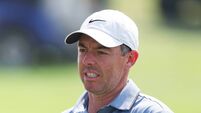Tiger sells himself short but not out of contention
UNFORTUNATELY, Tiger Woods played with caution. That is why one day into the 138th Open Championship, the world’s greatest player is hard to find, buried well down the leaderboard.
No, you can’t go so far as to say he shot himself out of contention, but sitting at 1-over 71, seven shots off the lead, Woods faces the largest first-round deficit in any of the 12 British Opens he has played as a professional.
A major championship machine? Sure he is, what with 14 in his possession. But remember this about Woods’ major recipe: Start fast, leap into the lead, then apply the firmest front-running grip golf has ever seen.
In other words, incomparable as he might be, Woods does not come from behind to win his majors, which makes his first-round start all the more stunning.
“I certainly made a few mistakes,” Woods said, and he recited those that were obvious.
Sloppy three-putt at par-4 10th.
Missed green at the 206-yard, par-3 15th.
Indifferent approach at the par-4 16th that trickled off the green and into a burn.
Shocking?
Well, yeah, except it’s very difficult to go forward when you’re back on your toes. And while it’s near impossible to second-guess anything Woods decides to do on the golf course, given his historic success, one is left to wonder if he didn’t put into a motion too conservative a Turnberry game plan on a day when scoring opportunities were plentiful.
Time and time again, Woods chose to attack with 2-irons rather than driver or 3-wood. Time and time again, he was left with much longer approach shots than his more aggressive playing competitors, Lee Westwood and Ryo Ishikawa, each of whom shot 68.
Woods shook his head.
“The wind was down,” he said. “Most of the holes I normally would be hitting 3-wood (but) with no wind, the 2-iron goes to the same spot.”
ONE could argue that Woods followed a similar philosophy in 2006 at Royal Hoylake – like Turnberry, a links he had not seen until Open Championship time rolled around. There, he pounded the golf course into submission with a series of 2-iron tee shots and rode an opening 67 to the second of his three Claret Jugs.
OK, except that Hoylake was a field of brown grass, its rock-hard turf a perfect match for Woods’ strategy.
Turnberry is nowhere as firm, the ball isn’t running to the sort of distances it did three summers ago at Hoylake, and thus are competitors required to take bolder routes.
Most did so and as twilight settled in, a whopping number (51) of players had a red number beside their name. Meanwhile, 1-over meant Woods was so far down the leaderboard he’ll be in need of a strong second round, just to make the cut.
Not the sort of start anyone expected from the overwhelming favourite, but don’t go thinking he immediately pushed the panic button. More likely, he’ll stick to his plan, one that was formulated after a routine that he’s established and stuck to.
Woods arrives at the British Open for practice rounds Sunday, Monday, and Tuesday, uses Wednesday to hit balls, then puts into motion his blueprint.
When he birdied the par-5 seventh to get 1-under and followed a stinger of a 2-iron tee shot with an approach to 15 feet at the par-4 eighth, the plan looked pretty good. But he missed that try, then missed the green at the 449-yard, par-4 ninth with a long approach made necessary by a safe iron off the tee.
Westwood and Ishikawa, meanwhile, pounded drivers at that ninth, and were yards ahead of Woods. That scene was played out several times coming home, but it’s pure conjecture as to how much that had to do with their 68s to get into the hunt and Woods’ 71 to sit somewhere near the Ailsa Craig.
But here is one man’s guess: It had a lot to do with it and may prompt Woods to reassess his game plan.
















